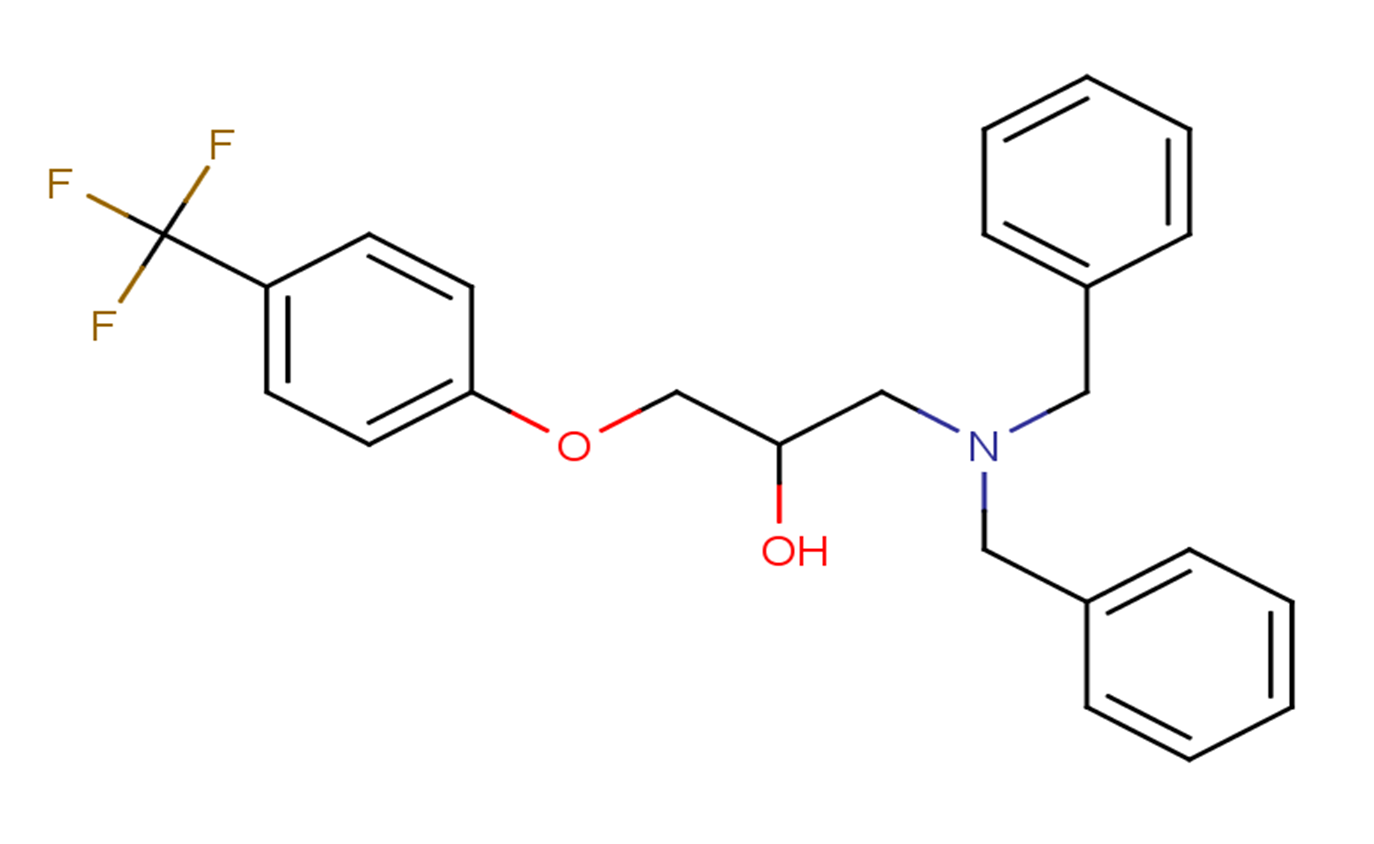Physicochemical Properties
| Molecular Formula | C24H24F3NO2 |
| Molecular Weight | 415.4481 |
| Exact Mass | 415.18 |
| Elemental Analysis | C, 69.38; H, 5.82; F, 13.72; N, 3.37; O, 7.70 |
| CAS # | 2222094-18-8 |
| PubChem CID | 134417552 |
| Appearance | White to off-white solid powder |
| LogP | 5.2 |
| Hydrogen Bond Donor Count | 1 |
| Hydrogen Bond Acceptor Count | 6 |
| Rotatable Bond Count | 9 |
| Heavy Atom Count | 30 |
| Complexity | 448 |
| Defined Atom Stereocenter Count | 0 |
| InChi Key | LGTYABNNHILKHF-UHFFFAOYSA-N |
| InChi Code | InChI=1S/C24H24F3NO2/c25-24(26,27)21-11-13-23(14-12-21)30-18-22(29)17-28(15-19-7-3-1-4-8-19)16-20-9-5-2-6-10-20/h1-14,22,29H,15-18H2 |
| Chemical Name | 2-Propanol, 1-[bis(phenylmethyl)amino]-3-[4-(trifluoromethyl)phenoxy]- |
| Synonyms | BC1618BC 1618BC-1618 |
| HS Tariff Code | 2934.99.9001 |
| Storage |
Powder-20°C 3 years 4°C 2 years In solvent -80°C 6 months -20°C 1 month |
| Shipping Condition | Room temperature (This product is stable at ambient temperature for a few days during ordinary shipping and time spent in Customs) |
Biological Activity
| ln Vitro | During CHX treatment, BC1618 improves the stability of the pAmpkα protein [1]. Compared to metformaldehyde, BC1618 stimulates pAmpkα activity in cells over a thousandfold [1]. A trend in pAmpkα and pACC protein levels is induced by BC1618 (0.1-2 μM, 16 hours), while BC1618 (1 μM) effectively breaks the link between Fbxo48 and pAmpkα while having no effect on Fbxo48, Ampkα1, or Ampkα2 messenger RNA. In human primary-like hepatocytes, dose-and time-dependent increases were also verified [1]. During intermittent depletion, BC1618 increases the abundance of several autophagy marker proteins. In line with the established mTOR inhibitory function played by activated Ampk, BC1618 decreases pS6 levels and phosphorylates the mTORC1-related protein Raptor [1]. |
| ln Vivo | In high-fat diet-induced electrode nozzles, BC1618 fosters ischemic defects, enhances autophagy, and improves diabetic insulin [1]. BC1618 exhibits superior electrode tolerance and seems to be roughly 1,000 times more effective than the dimethyl bielectrode. With a peak value of 2 in 0.5 hours following 20 mg/kg in the blood vessel wall, BC1618 exhibits remarkable blood vessel wall bioavailability. 000ng/mL, with blood vessels reaching a peak value of 500ng/mL after 4 hours[1]. |
| Cell Assay |
Western Blot analysis [1] Cell Types: BEAS-2B cells. 1]. Tested Concentrations: 0-2μM. Incubation Duration: 16 hrs (hours). Experimental Results: The induced pAmpkα and pACC protein levels were dose-dependent. |
| Animal Protocol |
Animal/Disease Models: C57BL/6 mice[1]. Doses: 2 or 10 mg/kg (challenge with LPS (3 mg/kg) for an additional 18 hrs (hrs (hours))). Management: IP, once. Experimental Results: Lung inflammation was diminished in endotoxin-treated mice. Animal/Disease Models: C57BL/6 mice[1]. Doses: 15 and 30 mg/kg/day. How to take: Drink water for 3 months. Experimental Results: No significant toxicity was demonstrated. |
| References |
[1]. A Fbxo48 inhibitor prevents pAMPKα degradation and ameliorates insulin resistance. Nat Chem Biol. 2021 Mar;17(3):298-306. |
Solubility Data
| Solubility (In Vitro) |
DMSO : ~100 mg/mL (~240.70 mM) H2O : < 0.1 mg/mL |
| Solubility (In Vivo) |
Solubility in Formulation 1: 2.5 mg/mL (6.02 mM) in 10% DMSO + 90% (20% SBE-β-CD in Saline) (add these co-solvents sequentially from left to right, and one by one), suspension solution; with sonication. For example, if 1 mL of working solution is to be prepared, you can add 100 μL of 25.0 mg/mL clear DMSO stock solution to 900 μL of 20% SBE-β-CD physiological saline solution and mix evenly. Preparation of 20% SBE-β-CD in Saline (4°C,1 week): Dissolve 2 g SBE-β-CD in 10 mL saline to obtain a clear solution. Solubility in Formulation 2: ≥ 2.5 mg/mL (6.02 mM) (saturation unknown) in 10% DMSO + 90% Corn Oil (add these co-solvents sequentially from left to right, and one by one), clear solution. For example, if 1 mL of working solution is to be prepared, you can add 100 μL of 25.0 mg/mL clear DMSO stock solution to 900 μL of corn oil and mix evenly. Solubility in Formulation 3: 5 mg/mL (12.04 mM) in 50% PEG300 50% Saline (add these co-solvents sequentially from left to right, and one by one), suspension solution; with ultrasonication. Preparation of saline: Dissolve 0.9 g of sodium chloride in 100 mL ddH₂ O to obtain a clear solution. (Please use freshly prepared in vivo formulations for optimal results.) |
| Preparing Stock Solutions | 1 mg | 5 mg | 10 mg | |
| 1 mM | 2.4070 mL | 12.0351 mL | 24.0703 mL | |
| 5 mM | 0.4814 mL | 2.4070 mL | 4.8141 mL | |
| 10 mM | 0.2407 mL | 1.2035 mL | 2.4070 mL |
